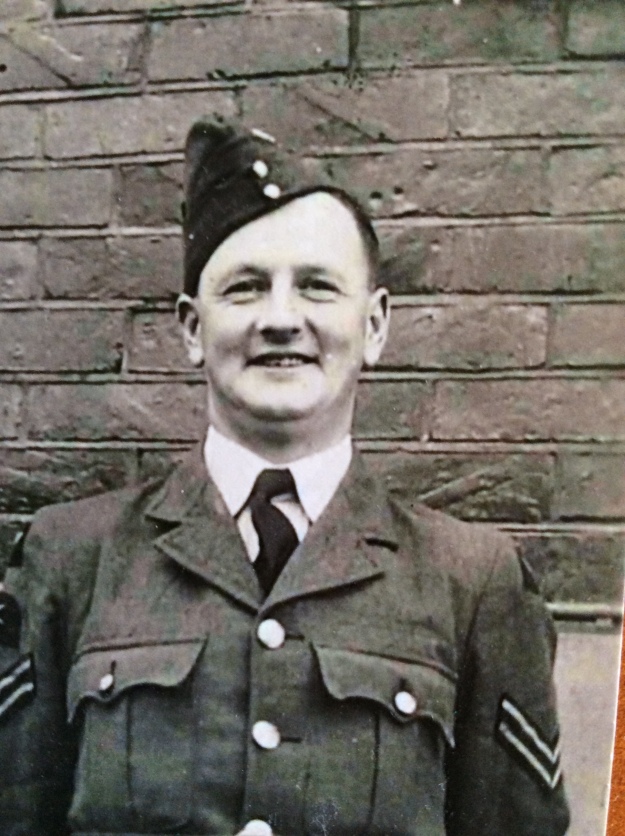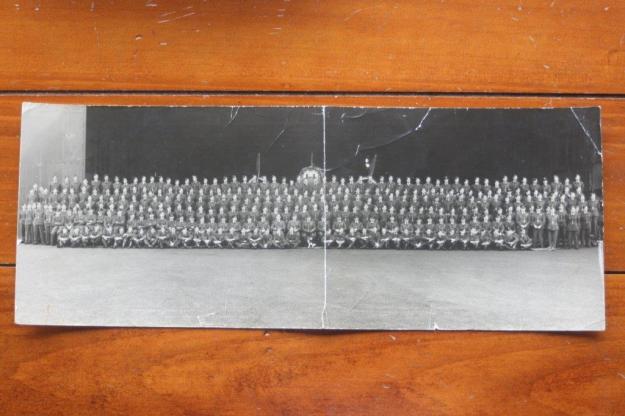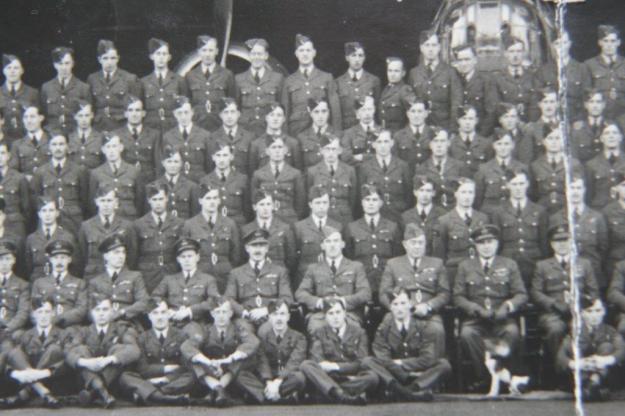Seeing that there was a search made for information on Terence Blewett I thought I would add a few details here. This way the searcher may be able to find more details for their future research. The first mention in the ORB is on 6 December 1944. Administration. NZ414376 F/O T. D. Blewett, NZ427270 F/S Flamark, R. J and crews arrived on posting from No.31 Base.
Terence flew a 2nd dickie trip (a flight with an experienced crew) on 11 December 1944 with Flt/Lt Harry Yates and crew. The Blewett crew then began their own tour of operations.
12 December 1944. Attack against Witten.
Sixteen aircraft were detailed to attack Witten in daylight and again found their target
obscured by ten tenths cloud. Moderate falk was encountered and enemy fighters were seen
attacking the first wave of aircraft ahead. No results were observed owing to the cloud.
The aircraft captained by F/Lt Hannan collided with another aircraft just before reaching
the target. However the target was bombed and base reached safely. The aircraft captained
by F/S Zinzan was damaged in landing and the Air Bomber, F/O Mesure sustained a broken
left leg
Lancaster I PB761 AA.Y Up 11:06 Down 16:23
F/O Blewett, T. Captain NZ414376
F/S Cornell, B. T. Nav 1398282
F/O Wilson, J. S. A/B NZ426234
W/O Smyrk, J. WO/Air –
Sgt Hunwicks, R. F/Eng –
Sgt Hollins, K. M/U/Gnr 2221435
Sgt Pridmore, W. H. R/Gnr –
Bomb load 1 x 4000 lb H.C, 14 x 500 lb ANM, 2 x 500 lb M.C.
Primary target Ruhrstahl Steelworks Witten.
Nothing to report.
16 December 1944. Attack against Siegen.
Eighteen aircraft took off to attack Siegen in rather poor weather conditions. Three aircraft
returned early with icing trouble. The main body experienced dense cloud and were unable to
formate until they reached 30E. All crews bombed the target several being able to see a built
up area through occasional gaps in the dense cloud cover. It is concluded that the attack was
successful. Some fighter and flak opposition was noticed on route but our aircraft experienced
no difficulty. Crew details as above.
21 December 1944. Attack against Trier.
Twenty aircraft were again detailed to attack Trier and all took off. Fourteen aircraft attacked
the target, the rest being obliged to jettision part of their loads on the return journey as
the leader of their formation was unable to release his bombs over the target. Those crews
attacking reported a good concentration with smoke rising above the cloud tops at the close
of the attack.
Crew details as above.
23 December 1944. Attack against Trier.
The 21 aircraft detailed on the 22nd December took off to attack Trier in improved weather conditions. The target could be identified visually and T.I.’s were aimed at by most crews. The attack was reported as being good with very few scattered bombs. Several explosions were seen as our aircraft left the target.
Crew details as above.
27 December 1944. Attack against Rheydt.
As many crews as possible were required for an attack on Cologne.
The target was cancelled and an attack on Rheydt substituted.
Inexperienced and special equipment leaders not being required, the offer of 26 a/c was reduced to 20. Visibility over the target was excellent and crews were able to identify the target, the flares being accurately placed. Clouds off smoke were seen to rise from the target. One aircraft captained by NZ421746 F/O H. Miles failed to return. This aircraft was seen to be hit by bombs from above, and to spiral down.
Crew details as above.
28 December 1945. Attack against Grenberg Marshalling Yards at Cologne.
Twenty one aircraft were detailed to attack the Grenberg Marshalling Yards at Cologne.
Nineteen aircraft bombed the target and one bombed short due to technical failure. One
aircraft captained by F/Off Sadgrove returned early owing to engine trouble. Crews were
satisfied that the attack was successful, many reporting smoke rising well above the cloud
tops. Slight Heavy Flak was experienced but no fighter opposition.
Crew details as above.
31 December 1944. Attack against Vohwinkel.
Seventeen aircraft were detailed to attack Vohwinkel in daylight. Moderate accurate heavy
flak was met over the target, but all aircraft returned safely. A scattered raid was reported.
Crew details as above.
1 January 45. Attack against Vohwinkel.
Twenty one aircraft were detailed to attack Vohwinkel, in daylight. Nineteen aircraft took off,
seventeen of which attacked the primary target. F/O McMillan attacked a last resort target.
NZ40984 W/Cdr R. J. Newton and NZ429286 P/O R. Aitchison as 2nd Pilot, failed to return. There was very little opposition in the target area.
Crew details as above.
3 January 45. Attack Against Dortmund Oil Refinery.
Fourteen aircraft were detailed to attack the above target in daylight. Crews bombed by
instruments in ten tenths cloud. Results were unobserved. NZ42397 F/L Hannan landed at
Mendalsham on return, but reached Base later the same evening.
Crew details as above.
5 January 45. Attack against Ludwigshafen.
Twenty one aircraft attacked Ludwigshafen in daylight. Visibility was clear. Heavy flak
was met, but all aircraft returned safely. A scattered raid was reported.
7/8 January 1945. Attack against Munich.
Seven of eight aircraft detailed attacked Munich in ten tenths cloud. Crews bombed on flares.
A mushroom explosion and red glow were observed through cloud. P/O Flamank in “P” returned early through a technical failure.
11 January 45. Attack against Krefeld.
Nineteen aircraft were detailed to attack Krefeld. Seventeen aircraft bombed the target in ten
tenths cloud with special equipment and two aircraft bombed last resort targets. Slight heavy
flak was met over the target, but no fighters were seen.
15 January 1945. Attack against Langendreer.
Eighteen aircraft were detailed to attack Langendreer. The aircraft captained by NZ427082 F/O D. Leadley failed to reach the target owing to starboard inner engine failing. No results were observed owing to ten tenths cloud. Flak was slight over the target. No fighter opposition was encountered.
16/17 January 1945. Attack against Wanne Eickel.
Seventeen aircraft attacked Wanne Eickel in ten tenths cloud, tops being 6-7,000 feet. Crews bombed with the aid of instruments and sky markers. Flak was moderate. The general impression was that bombing was concentrated on markers and red glow seen through cloud. A short inconclusive combat took place between the aircraft captained by NZ426235 F/S Wood and a Fw.190. The aircraft captained by NZ414376 F/L T. Blewett unfortunately crashed in this country. The captain and air bomber NZ426234 F/O J. Wilson were killed and the navigator 1398282 F/S Cornell died as the result of injuries.
Lancaster I PB761 AA.Y Up 23:30 F/O Blewett, Terence Douglas Captain NZ414376
F/S Cornell, Bryant Thomas Nav 1398282
F/O Wilson, John Stanley A/B NZ426234
W/O Smyrk, J. WO/Air –
Sgt Hunwicks, Ronald F/Eng –
Sgt Hollins, Kenneth M/U/Gnr 2221435
Sgt Pridmore, William H. R/Gnr –
Bomb load 1 x 4000 lb H.C, 10 x 500 lb G.P, 2 x 500 lb M.C, 4 x 250 G.P.
Primary target Wanne Eickel.
Took off from Mepal at 23:30 hours to attack the benzol-plant. On return crashed into high
ground near Wood Dutton, 13 miles east of Cambridge. The pilot and bomb aimer were killed
in the crash, and the navigator died of his injuries the next day. All the other crew members
were injured. The crash site is listed as near Hill Farm, Kirtling.














